Top News
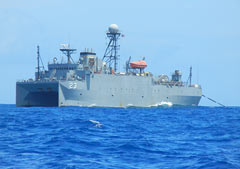
June 7, 2014 Kenichi Yoshida and Shinji Sano of Ryukyu Shimpo
Seven tuna fishing boats had their lines cut off one after another in waters near the main Island of Okinawa. The fishing industry suspects a U.S. Navy vessel was involved in the incidents. The captain of Daiichi Kotobuki Maru, which belongs to the Okinawa Tuna Fishing Cooperative Association, said on June 6 that the U.S. Navy Ocean Surveillance Ship T-AGOS 23 Impeccable repeatedly sailed past where the lines were anchored. The captain took pictures of the U.S. naval vessel sailing on the sea, about 800 meters away from his boat.
Between mid-May and June, such incidents took place continuously in waters about 110 kilometers southwest of the main Island of Okinawa. As of May 28, the Okinawa Prefectural Government (OPG) received 15 incident reports from seven tuna boats. After that, the OPG confirmed another three cases. The damage from 18 cases has amounted to several million yen. The OPG and the Okinawa Prefecture Fishery Cooperative asked the U.S. military to provide information on the incidents through the Okinawa Defense Bureau. Two weeks later, there was still no answer from U.S. military as of June 6.
The captain of Daiichi Kotobuki Maru said, “It is almost certainly that the U.S. Navy ship cut off the long lines. The U.S. military may not admit its fault for the protection of the military secrets. But, we will not allow the U.S. military to hide the incidents. The U.S. military should pay to compensate for damages caused as soon as possible.”
It has been confirmed that the U.S. Navy Ocean Surveillance Ship often visits Naha Military Port and White Beach. The vessel is equipped with a low frequency active sonar system to explore underwater. It uses sonar rays under water. The captain said, “The Ocean Surveillance Ship cut off our longlines with its sonar. Cargo ships have always pass near our boats, but they have not affected our operation. If there was prior announcement from the U.S. military we could have changed the location for setting the longlines.”
Wataro Lai , a member of the civil organization Rimpeace, established to monitor the U.S. military’s activities, said, “The Impeccable is a large Ocean Surveillance Ship, which has a transmitter sonar that extends vertically from the hull of the ship and a passive sonar that extends parallel to the surface of the sea. It is able to detect a submarine using this sonar system.” He also pointed out the possibility that the ocean surveillance ship had cut off the longlines with its passive sonar when it passed near the fishing place.
(English translation by T&CT)
Go to Japanese
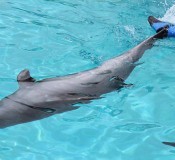
June 4, 2014 Ryukyu Shimpo
Bottlenose dolphin “Fuji” ,from the Ocean Expo Park in Motobu Town, has a new artificial tail fin. The dolphin swam with the new fin after a final fitting test was carried out on May 31.
The designers improved a “cowling” feature, which stabilizes the rubber-made artificial fin onto the dolphin’s tail fin.
The new fin does not have screws that need tightening, so it is more comfortable for the dolphin and more durable.
Fuji swam around in the pool with her daughter Connie, as if showing off her new comfortable fin to developers.
The dolphin joined the Ocean Expo Park since 1978. In 2002, part of her tail fin had to be cut off because of an unknown disease. Later, the Churaumi Aquarium and auto manufacturer Bridgestone Group worked together to develop an artificial tail fin. Bridgestone has so far developed 38 fins of eight different kinds.
Shingo Kato of the Bridgestone Flowtech said, “We can now use the outcome of long-term design research for Fuji for other dolphins.” A member of the breeding staff, Suguru Higa said, “Visitors can enjoy seeing the aged dolphin swimming energetically with the artificial fin.”
(English translation by T&CT and Megumi Chibana)
Go to Japanese
June 8, 2014 Wu Li Jun of the Ryukyu Shimpo
China Eastern Airlines plans to launch regular flights between Naha and Chengdu district of Sichuan province in Southwest China in the middle of July.
The company will apply to the Ministry of Land, Infrastructure and Transport to commence flights. It will launch round-trip flights three times a week by using the Boeing 737 with 165 seats. There are two regular flight services between Naha and cities of the mainland of China, including Shanghai and Beijing. Chengdu will be the third city to connect the mainland of Okinawa with China by air.
The airline company will operate the flight between Naha and Shanghai once a week. Customers using the flight will be from Chengdu and Chongqing as well as Shanghai.
The head of the Okinawa branch of the company Yin Shujian said, “Resort tourism is popular in Japan. Chengdu is located inland so many citizens like to see the ocean.” Yin went on to say, “We decided to launch the flight between Naha and Chengdu because Okinawa is rich in sightseeing resources and less than three hours away from Chengdu.”
Chengdu is the capital of Sichuan province in Southwest China with a population of 14 million. In east Sichuan, there is Chongqing, which is the administrative city of the Chinese government and has a population of 29 million.
(English translation by T&CT)
Go to Japanese
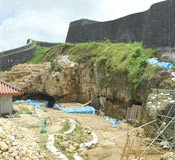
June 3, 2014 Ami Chibana of Ryukyu Shimpo
On the site of Shurijo Castle Park in the Tonokura district of Shuri, Naha, lies Ryukon Go Cave, built by male students of the Okinawa Teacher’s School during the Battle of Okinawa.
The park administration office plans to preserve the cave.
It was completed by the students around March 1945, just before the U.S. military landed on the main Island of Okinawa. After they landed, the students used the hideout to contribute to the war effort on behalf of the Japanese Imperial Army. In a section of the cave, the local wartime newspaper Okinawa Shimpo was published.

Citizens are not normally allowed to enter the cave, located at the back of the main temple of the castle.
The office plans to open the cave to the public, along with Ryukyuan dynasty remains found nearby in 2018. By using the cave, park administrators aim to tell the story of the Battle of Okinawa.
Staff member Hiroshi Chinen said, “Although we cannot allow people to enter the cave because of the danger of rocks falling, we would like to allow them to view it from outside.”
The office asked the Okinawa Prefectural Archaeological Center to survey an area which includes the cave as part of the survey for restoration and maintenance of the castle from the fiscal 2012 to 2013.
Before the survey, two of three cave entrances were buried in the soil.
Tsutomu Arakaki of the center said, “We continued to excavate the west entrance to find a cavity, which is 1,000 square meters. Contrary to the testimonies on the cave, it has several rooms.”
Glossary: Ryukon Go Cave
The cave is located at the site of the Okinawa Prefectural University of Arts. Male students of the Okinawa Teacher’s School excavated it just before the Battle of Okinawa. It has three entrances. The cave is 1.8 meters tall, 2 meters wide and about 30 meters in depth. The total length of the tunnel in the cave is about 100 meters. One section was used as the wartime headquarters for Okinawa Shimpo publications.
(English translation by T&CT)
Go to Japanese
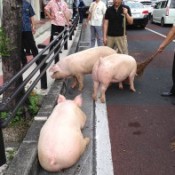
May 31, 2014 Ryukyu Shimpo
Eight pigs’ ran away on the national highway in Yonabaru during traffic congestion, causing a major scene. At around 8:45 a.m. on May 30, at the intersection in Yonabaru, a barrier on the rear part of a cargo truck carrying about 30 pigs, fell down, and eight pigs ran away. About 20 police from the Yonabaru Police Station rushed to the scene and 15 staff members from a construction company Terumasa Co. assisted to catch the pigs.
The pigs fled onto the road in front of the building of Terumasa Co. Hearing the pigs’ cries, staff members of the company came out of their office, and saw three animals walking on the road. Another three ran away towards the direction of Sashiki. Employees at the scene succeeded in chasing the animals into a parking lot with brooms. The two pigs that ran away in the Yonabaru Police Station direction were caught at its parking lot.
There were no injuries or accidents as a result of the pigs escaping.
Yuji Arima, the security section chief of Yonabaru Police Station, said, “It was lucky for us and the pigs that this did not become a serious accident.” Shigeya Tamaki, a staff member of Terumasa Co. guessed they might have run away from a fear of being cooked for Soki Jiru (Okinawan soup with pork).
(English translation by T&CT)
Go to Japanese
May 24, 2014 Ryukyu Shimpo
Chuya Shinzato and his research team at the Okinawa Institute of Science and Technology Graduate University (OIST) announced on May 23 that they had established a technique to identify individual Acropora coral through DNA testing. The Acropora is the world’s most common coral with 113 known species.
The technique enables scientists to study genetic diversity and connectivity between the coral populations. This will help conserve coral reef ecosystems in the world. Shinzato said, “We would like to make practical use of this technique.”
Researchers have not previously known about the genetic connections between corals. For instance, they now know that some coral share genes coming from the same individual.
Shinzato and his team developed 14 microsatellite DNA markers to identify individuals. About 30 percent of all coral species in the world are found in the seas around Okinawa. They said the technique they have developed would enable an in increase genetic diversity in coral plantation, which would help coral survive through environmental changes. Reefs with a diversity of coral are more robust to environmental changes than those composed of only few individual corals.
(English translation by T&CT, Hitomi Shinzato)
Go to Japanese
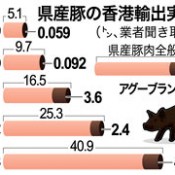
June 3, 2014 Ryukyu Shimpo
Okinawan pork exports to Hong Kong have increased by more than double.
According to a government survey on meat distributors in the prefecture, pork exports for the 2013 fiscal year amounted to 40.9 tons – a new record. This represents a 61.5 percent increase from the previous year. Out of the total exports, agu pork, a traditional breed of Ryukyuan pig, amounted to 4.2 tons, a 73.1 percent increase from the previous year.
Setting up cold storage warehouses in Hong Kong and promoting Okinawan pork helped the industry boost sales.
The government aims to sell 50 tons of pork products by fiscal 2016. A spokesperson from the OPG said, “We think that we can reach our goal within this year. Sales are increasing faster than expected.”
By using state subsidies from fiscal 2012, the government has been working on a project to promote Okinawan pork brands in and outside Japan.
As part of the project, the government set up cold storage warehouses in Hong Kong, which allowed meat distributors to export large amounts of pork at one time.
Okinawan pork exports are now eight times what they were in fiscal 2009, when the companies started to work on exporting the pork.
Exports of agu pork for fiscal 2013 are 70 times what they were in fiscal 2009.
Exports of Okinawan beef and chicken egg have also been increasing since 2010.
An increase in flights between Naha and Hong Kong has contributed to the boost in Okinawan food exports.
Dragon air increased flights from two to four a week in 2012 and Hong Kong Airlines increased flights from 7 to 14 a week in 2014.
Suguru Toguchi, who belongs to the Hong Kong branch of the Okinawa Industry Promotion Public Corporation, said, “An increase in the number of regular customers from Hong Kong to Okinawa has contributed to increasing demand for Okinawan products in Hong Kong.”
In November 2013, seven groups, including Okinawan meat distributors, created an organization to promote Okinawan meat export. The organization is sending two of its staff to Hong Kong on exchange programs.
Companies represented by the the organization hire Hong Kong staff and work on promotion such as holding monthly tasting and sales events.
Kiyota Shingaki from the organization said, “Exports are increasing steadily. We need to continue promotion because consumers can be fickle in Hong Kong.”
(English translation by T&CT)
Go to Japanese
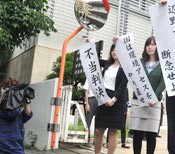
May 28, 2014 Ryukyu Shimpo
On May 27, the Naha branch of the Fukuoka High Court passed a judgment on the initial appeal of about 300 citizens living near Camp Schwab in the Henoko district of Nago. The U.S. and Japanese governments plan to move U.S. Marine Corps Air Station Futenma to the area, which would involve major dredging and construction on Oura bay. However, residents opposing the plan say it will damage their livelihood. The plaintiffs alleged the approach to the environmental impact assessment for the plan was unsatisfactory. They filed an appeal seeking a reassessment and damages. Justice Hidekazu Imaizumi dismissed the appeal, upholding the decision of the Naha District Court at the first trial. He stated that he “cannot recognize the right of the residents to declare their opinion” on the procedure of the environmental impact assessment (EIA). He did not express a judgment on the illegality of the assessment, which the residents were asserting. The residents are considering an appeal to the Supreme Court.
During the lawsuit, Henoko residents debated with the Japanese government over the rights of local citizens to demand a reassessment.
The residents claimed that the central government withheld key information during the assessment process, only releasing it when it was too late for the community to express their views. They claimed the government had infringed on the right of residents to be consulted on their views on the environmental assessment.
The judge knocked back the residents’ demand for an opportunity to express their views on the procedure of the EIA. Imaizumi claimed that the government was more equipped to conduct accurate research on the natural environment than a survey done by private research companies.
Furthermore, the plaintiffs claimed the anticipated noise from U.S. military planes would compromise the quality of life of residents living near the proposed site for the air base. They argued that future civil legal action against US military aircraft noise was unlikely to be successful, considering the precedent of unsuccessful cases in Okinawa.
However, Imaizumi dismissed the claim, without offering a concrete resolution. He stated that he was ” unable to find evidence that there is no other way to avoid such damage.”
Leader of the plaintiffs Hiroshi Ashitomi said this was an “unjust judgment.”
(English translation by T&CT and Lima Tokumori)
Go to Japanese
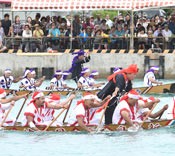
June 2, 2014 Ryukyu Shimpo
On May 4 of the old lunar calendar (June 1), also known as Yukka-nu-hi, Harley dragon-boat races were held in various locations around Okinawa to wish for a safe and prosperous fishing season.
The Harley race held at the Itoman Fishing Port attracted many spectators, who were excited by the festive race atmosphere.
Teams from the old villages of Itoman, Nishimura, Nakamura and Nijima, competed in three races in newly made Harley boats.
They competed in the Ugan-Barley boat race, Kunukase race (flip-over boat race) and Agaisubu race (a long-distance race of 2.15 kilometers).
Nishimura won the overall champion’s flag for the second consecutive year.
At the climax of the Agaisubu race, Nishimura recorded a new best time of 12 minutes and 22.61 seconds, winning the first place.
Masashi Uehara of Nishimura said, “We were able to win the competition because we supported one another. I am grateful for the support from our village.”
(English translation by T&CT)
Go to Japanese
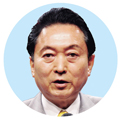
June 1, 2014 Ryukyu Shimpo
The East Asian Community Research Institute held a symposium to commemorate the opening of the Ryukyu Okinawa Center in Naha at a hotel in Naha. About 700 people, including scholars and peace advocates, took part in the May 31 symposium. They discussed the potential role that Okinawa could play in East Asia. The president of the institute is former Prime Minister Yukio Hatoyama.
Referring to the former Ryukyu Kingdom, which flourished in trade with the countries of East Asia, the former prime minister stressed Okinawa’s potentially central role in maintaining peace. “Okinawa, being located in the middle of East Asia, has advantages not only geographically, historically, and culturally but also in political and administrative areas. It is one of the regions offering a bright hope,” he said. “Okinawa became a sacrificial stone to protect the mainland of Japan from the United States during the Battle of Okinawa. It has served as the cornerstone of military power after the war. We look forward to a day when Okinawa will serve as a hub or the cornerstone for peace in East Asia.”
After the symposium, Hatoyama commented on the Futenma issue, “There remains sufficient possibility to move it out of Japan. The government has a hard-line approach to people opposing the relocation plan. We will support Okinawan people in expressing their opinion.” He declared that he would work to oppose relocating the Futenma base within the prefecture, respecting the popular will of Okinawa.
Eiichi Shindo, an emeritus professor at the University of Tsukuba and the president of the International Academic Society for Asian Community, Hajime Takano, the editor-in-chief for the magazine Insider and Ukeru Magosaki, a former director of the Intelligence and Analysis Bureau of the Foreign Affairs Ministry, also gave lectures at the symposium. Nago Mayor Susumu Inamine also reported on his activities on the Futenma issue during his visit to the United States.
(English translation by T&CT)
Go to Japanese
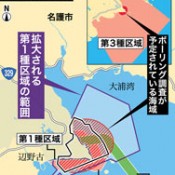
May 30, 2014 Ryukyu Shimpo
The government will expand the restricted area for fishing near the planned relocation site for Futenma Air Base.
The government regulates fishing in the water surrounding the relocation site at Henoko based on the Restriction on Operation of Fishing Vessels Act. Currently, this area is set as Water area 1, where operation of fishing vessels is prohibited at all times up to 50 meters offshore from the coast. The government will expand the restricted area up to about two kilometers from the coast. The government is scheduled to start a drilling survey on the sea floor. Observers of the Henoko-relocation issue speculate that the government is trying to prevent opponents of the relocation plan from accessing the area.
In addition to the expansion of the prohibited area, the government is coordinating with the U.S. side to expand the Camp Schwab water area, based on a “5.15 memorandum” agreement in which Japan and the United State decided the provision and conditions of use of the U.S. military facilities and training areas. Within Water area 1, fishing boats are prohibited access. But, canoes, which were used in protests in the past, are exempt from this regulation. The government is considering making water craft other than fishing vessels subject to this regulation.
The government has designated the areas off the coast of Camp Schwab as water area 1 to 4. Within water area 1, fishing is banned at all times, and within water area 2 net fishing is banned. Within water area 3 or 4 fishing is banned during training and exercise activities. The Ministry of Defense has asked the Okinawa Prefectural Government to provide its opinion through the Ministry of Agriculture, Forestry and Fisheries. The Okinawa Prefectural Government sent letters to the Nago fishery cooperatives and the Nago City Office to request their views on May 27.
By reviewing the restricted area, the government will expand water area 1 into water area 2, where fishing is currently allowed provided it does not interfere with military operations. This will increase the area where fishing is restricted at all times, and dedicate it for exclusive use by U.S. Forces. The revised boundaries are scheduled to be agreed on at the Japan-US Joint Committee in the near future. But government officials would not reveal further details of the consultation .
(English translation by T&CT)
Go to Japanese










 Webcam(Kokusai Street)
Webcam(Kokusai Street)


